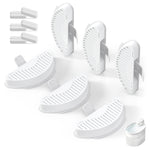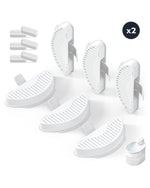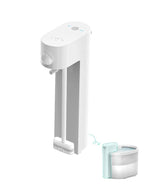Living with allergies and pets can be a challenge, especially when it comes to maintaining clean and breathable air in your home. Room air purifiers have become an essential tool for many households, offering relief from allergens and pet dander. This comprehensive guide will explore how these devices work, their benefits, and what to look for when choosing the right one for your needs.
Understanding Allergies and Pet Dander
Allergies are a common issue for many people, and pet dander is one of the leading causes. Pet dander consists of tiny, even microscopic, flecks of skin shed by cats, dogs, rodents, birds, and other animals with fur or feathers. These particles can linger in the air and settle on surfaces, triggering allergic reactions in sensitive individuals.
Common symptoms of pet allergies include sneezing, runny or stuffy nose, itchy or watery eyes, and even asthma attacks. For those who love their pets but suffer from allergies, finding effective solutions is crucial. This is where room air purifiers come into play.
How Room Air Purifiers Work
Room air purifiers are designed to remove contaminants from the air, including allergens, pet dander, dust, pollen, and even odors. They work by drawing in air from the room, passing it through a series of filters, and then releasing clean air back into the environment.
The most common types of filters used in air purifiers include:
- HEPA Filters: High-Efficiency Particulate Air (HEPA) filters are highly effective at capturing particles as small as 0.3 microns, including pet dander, pollen, and dust mites.
- Activated Carbon Filters: These filters are excellent at removing odors and volatile organic compounds (VOCs) from the air, making them ideal for homes with pets.
- Pre-Filters: These are the first line of defense, capturing larger particles like pet hair and dust, which helps prolong the life of the main filter.
Some air purifiers also feature additional technologies, such as UV-C light or ionizers, to further enhance air quality by neutralizing bacteria, viruses, and other microorganisms.
Benefits of Room Air Purifiers for Allergies and Pets
Investing in a room air purifier can offer numerous benefits, especially for those with allergies and pets. Here are some of the key advantages:
- Reduction of Allergens: By capturing pet dander, pollen, and dust mites, air purifiers can significantly reduce the presence of allergens in your home, providing relief for allergy sufferers.
- Improved Air Quality: Cleaner air means a healthier living environment for everyone in the household, including your pets.
- Odor Elimination: Activated carbon filters can help eliminate unpleasant odors caused by pets, such as urine or litter box smells.
- Better Sleep: Improved air quality can lead to better sleep, as allergens and irritants are less likely to cause nighttime discomfort.
- Protection for Pets: Air purifiers can also benefit your pets by reducing their exposure to airborne pollutants, which can improve their overall health and well-being.
Choosing the Right Room Air Purifier
With so many options available, selecting the right room air purifier can be overwhelming. Here are some factors to consider when making your decision:
- Room Size: Ensure the air purifier is suitable for the size of the room where it will be used. Most models specify the maximum square footage they can effectively cover.
- Filter Type: Look for a purifier with a HEPA filter for allergen removal and an activated carbon filter for odor control.
- Noise Level: Consider the noise level of the purifier, especially if it will be used in a bedroom or other quiet space.
- Maintenance: Check how often the filters need to be replaced and the cost of replacement filters.
- Additional Features: Some purifiers come with features like air quality sensors, auto mode, and timer settings, which can enhance convenience and efficiency.
Tips for Maximizing the Effectiveness of Your Air Purifier
To get the most out of your room air purifier, follow these tips:
- Placement: Position the purifier in a central location within the room, away from walls and furniture, to ensure optimal air circulation.
- Regular Cleaning: Keep the area around the purifier clean to prevent dust and pet hair from accumulating and clogging the filters.
- Filter Replacement: Replace filters as recommended by the manufacturer to maintain the purifier's effectiveness.
- Use Continuously: For best results, run the purifier continuously, especially in rooms where you and your pets spend the most time.
- Combine with Other Measures: Use the purifier in conjunction with other allergy-reducing strategies, such as regular vacuuming, washing pet bedding, and grooming your pets frequently.
Common Misconceptions About Room Air Purifiers
There are several misconceptions about room air purifiers that can lead to confusion. Here are a few to be aware of:
- Air Purifiers Can Eliminate All Allergens: While air purifiers can significantly reduce allergens, they cannot eliminate them entirely. It's important to combine their use with other allergy management strategies.
- All Air Purifiers Are the Same: Not all air purifiers are created equal. Different models have varying levels of effectiveness, depending on the type of filters and technologies they use.
- Air Purifiers Can Replace Ventilation: Air purifiers are not a substitute for proper ventilation. It's still important to open windows and doors regularly to allow fresh air to circulate.
- Air Purifiers Are Only for Allergies: While they are highly effective for allergy sufferers, air purifiers can also benefit those without allergies by improving overall air quality.
Room Air Purifiers and Pets: What You Need to Know
If you have pets, there are a few additional considerations to keep in mind when using a room air purifier:
- Pet Hair: While air purifiers can capture pet dander, they may not be as effective at removing larger particles like pet hair. Regular vacuuming and grooming are still necessary.
- Pet Safety: Ensure that the air purifier is safe for use around pets. Avoid models that produce ozone, as it can be harmful to both humans and animals.
- Multiple Pets: If you have multiple pets, you may need a more powerful purifier or multiple units to effectively manage the increased amount of dander and hair.
- Pet-Friendly Features: Some purifiers come with pet-specific features, such as a pre-filter designed to capture pet hair more efficiently.
The Future of Room Air Purifiers
As technology continues to advance, room air purifiers are becoming more sophisticated and effective. Future developments may include:
- Smart Purifiers: Integration with smart home systems, allowing you to control the purifier remotely and monitor air quality in real-time.
- Enhanced Filtration: New filter materials and technologies that can capture even smaller particles and neutralize a wider range of pollutants.
- Energy Efficiency: More energy-efficient models that consume less power while maintaining high performance.
- Customization: Purifiers that can be customized to target specific allergens or pollutants, providing tailored solutions for individual needs.
Room air purifiers have come a long way in recent years, and their importance in maintaining clean and healthy indoor air cannot be overstated. Whether you're an allergy sufferer, a pet owner, or simply someone who values good air quality, investing in a room air purifier can make a significant difference in your home environment. With the right purifier and proper maintenance, you can enjoy cleaner air, fewer allergens, and a healthier lifestyle for both you and your pets.












